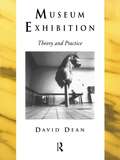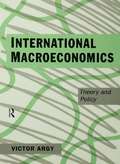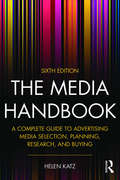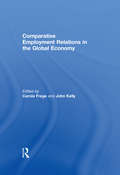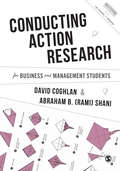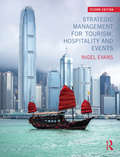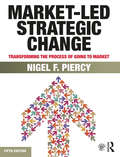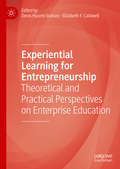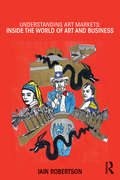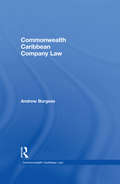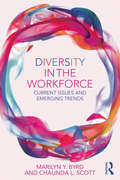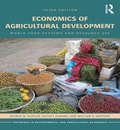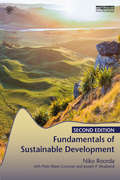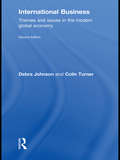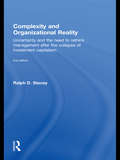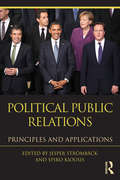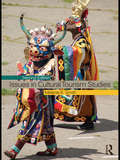- Table View
- List View
Museum Exhibition: Theory and Practice (Heritage: Care-Preservation-Management)
by David DeanMuseum Exhibition is the only textbook of its kind to consider exhibition development using both theory and practice in an integrated approach. This comprehensive study covers care of exhibits, writing accompanying text, using new technology, exhibition evaluation, administration and content for a wide range of collections. It provides a complete outline for all those concerned with providing displays in musuems and other cultural heritage contexts.
International Macroeconomics: Theory and Policy
by Victor ArgyInternational Macroeconomics: Theory and Policy offers phenomenal coverage across the entire subject of international macroeconoimics in an open economy context. The book has four objectives: * to describe the evolution of and experiences with global exchange rate regimes * to introduce the reader to a rigorous analysis of open economy models * to apply the model framework to address key policy issues * to review individual country experiences of macro policy
The Media Handbook: A Complete Guide to Advertising Media Selection, Planning, Research, and Buying (Lea’s Communication Series)
by Helen KatzThe Media Handbook provides a practical introduction to the advertising media planning and buying processes. Emphasizing basic calculations and the practical realities of offering alternatives and evaluating the plan, this sixth edition reflects the critical changes in how advertising in various media is planned, bought, and sold by today’s industry professionals. Author Helen Katz looks at the larger marketing, advertising, and media objectives, and follows with an exploration of major media categories, covering paid, owned, and earned media forms, including digital media. She provides a comprehensive analysis of planning and buying, with a continued focus on how those tactical elements tie back to the strategic aims of the brand and the client. Also available is a Companion Website that expands The Media Handbook’s content in an online forum. Here, students and instructors can find tools to enhance course studies such as chapter overviews, PowerPoint slides, and sample questions. With its emphasis on real-world industry practice, The Media Handbook provides an essential introduction to students in advertising, media planning, communication, and marketing. It serves as an indispensable reference for anyone pursuing a career in media planning, buying, and research.
Comparative Employment Relations in the Global Economy: In The Global Economy
by Carola Frege John Kelly"Employment Relations" is widely taught in business schools around the world. Increasingly however more emphasis is being placed on the comparative and international dimensions of the relations between employers and workers. It is becoming ever more important to comprehend today’s work and employment issues alongside a knowledge of the dynamics between global financial and product markets, global production chains, national and international employment actors and institutions and the ways in which these relationships play out in different national contexts. This textbook is the first to present a cross-section of country studies, including all four BRIC countries, Brazil, Russia, India and China alongside integrative thematic chapters covering all the important topics needed to excel in this field. The textbook also benefits from the editors' and contributors' experience as leading scholars in Employment Relations. The book is an ideal resource for students on advanced undergraduate and postgraduate comparative programmes across areas such as Employment Relations, Human Resource Management, Political Economy, Labour Politics, Industrial and Economic Sociology, Regulation and Social Policy.
Conducting Action Research for Business and Management Students (Mastering Business Research Methods)
by Professor David Coghlan Professor Abraham B. ShaniIn Conducting Action Research, Coghlan and Shani explain how action research differs from more detached research methods and provides expert guidance on how to engage effectively with it, helping the reader to complete both a successful research project and produce findings that are useful in an organizational context. Ideal for Business and Management students reading for a Master’s degree, each book in the series may also serve as reference books for doctoral students and faculty members interested in the method. Part of SAGE's Mastering Business Research Methods, conceived and edited by Bill Lee, Mark N. K. Saunders and Vadake K. Narayanan and designed to support researchers by providing in-depth and practical guidance on using a chosen method of data collection or analysis. Watch the editors introduce the Mastering Business Research Methods series
Comparative Employment Relations in the Global Economy
by Carola Frege John Kelly"Employment Relations" is widely taught in business schools around the world. Increasingly however more emphasis is being placed on the comparative and international dimensions of the relations between employers and workers. It is becoming ever more important to comprehend today’s work and employment issues alongside a knowledge of the dynamics between global financial and product markets, global production chains, national and international employment actors and institutions and the ways in which these relationships play out in different national contexts. This textbook is the first to present a cross-section of country studies, including all four BRIC countries, Brazil, Russia, India and China alongside integrative thematic chapters covering all the important topics needed to excel in this field. The textbook also benefits from the editors' and contributors' experience as leading scholars in Employment Relations. The book is an ideal resource for students on advanced undergraduate and postgraduate comparative programmes across areas such as Employment Relations, Human Resource Management, Political Economy, Labour Politics, Industrial and Economic Sociology, Regulation and Social Policy.
Strategic Management for Tourism, Hospitality and Events
by Nigel EvansStrategic Management for Tourism, Hospitality and Events is the must-have text for students approaching this subject for the first time. It introduces students to fundamental strategic management principles in a Tourism, Hospitality and Events context and brings theory to life by integrating a host of industry-based case studies and examples throughout. Among the new features and topics included in this edition are: Extended coverage to Hospitality and Events to reflect the increasing need and importance of a combined sector approach to strategy New international Tourism, Hospitality and Events case studies from both SME’s and large-scale businesses are integrated throughout to show applications of strategic management theory, such as objectives, products and markets and strategic implementation. Longer combined sector case studies are also included at the end of the book for seminar work. New content on emerging strategic issues affecting the tourism ,hospitality and events industries, such as innovation, employment, culture and sustainability Web Support for tutors and students providing explanation and guidelines for instructors on how to use the textbook and case studies, additional exercises, case studies and video links for students. This book is written in an accessible and engaging style and structured logically with useful features throughout to aid students’ learning and understanding. This book is an essential resource to Tourism, Hospitality and Events students.
Strategic Management for Tourism, Hospitality and Events
by Nigel EvansStrategic Management for Tourism, Hospitality and Events is the must-have text for students approaching this subject for the first time. It introduces students to fundamental strategic management principles in a Tourism, Hospitality and Events context and brings theory to life by integrating a host of industry-based case studies and examples throughout. Among the new features and topics included in this edition are: Extended coverage to Hospitality and Events to reflect the increasing need and importance of a combined sector approach to strategy New international Tourism, Hospitality and Events case studies from both SME’s and large-scale businesses are integrated throughout to show applications of strategic management theory, such as objectives, products and markets and strategic implementation. Longer combined sector case studies are also included at the end of the book for seminar work. New content on emerging strategic issues affecting the tourism ,hospitality and events industries, such as innovation, employment, culture and sustainability Web Support for tutors and students providing explanation and guidelines for instructors on how to use the textbook and case studies, additional exercises, case studies and video links for students. This book is written in an accessible and engaging style and structured logically with useful features throughout to aid students’ learning and understanding. This book is an essential resource to Tourism, Hospitality and Events students.
Market-Led Strategic Change: Transforming the process of going to market
by Nigel F. PiercyMarket-Led Strategic Change, 5th edition, has been fully revised and updated to reflect the realities of 21st century business and the practical issues for managers in the process of going to market. The world of business has changed dramatically, with a more complex environment, more demanding customers and radical new ways of going to market. This textbook develops a value-based strategy examining the roles of market sensing, customer value, organizational change and digital marketing in the implementation of strategy. This much-anticipated new edition has been carefully updated, now with Nigel Piercy’s unique and clear-sighted views on the latest developments in marketing strategy, retaining Piercy’s insightful, witty and provocative style. The text is supported throughout with brand new case studies from globally recognised companies such as Uber and Volkswagen, and covering topical issues such as the legalisation of marijuana and reinventing the healthcare business. Lecturers are assisted with a newly expanded collection of support materials including PowerPoint slides for each chapter, suggested frameworks for using the case studies in teaching, and case studies from previous editions. If you're an ambitious marketing student or practitioner, whether you are new to strategic change through marketing or just want a different view, this is the book for you. Lecturers will find this engaging, funny, thought-provoking but always practical textbook is a sure way to get your students thinking and enthused.
Experiential Learning for Entrepreneurship: Theoretical and Practical Perspectives on Enterprise Education
by Denis Hyams-Ssekasi Elizabeth F. CaldwellThis topical new book provides an illuminating overview of enterprise education, and poses the question as to whether current establishments have adequate systems in place to prepare students for the world of work. Addressing the increasing need for graduates with practical skills and expertise in the labour market, this collection of insightful chapters analyses the opportunities that are available for aspiring entrepreneurs to develop enterprise skills and experience key aspects of starting and running a business, whilst in a supported environment such as an educational program or incubator scheme. With comprehensive discussion of higher education initiatives and empirical examples of experiential learning in the workplace, this book is an important and timely read for those researching business enterprise, entrepreneurship and higher education more generally.
Experiential Learning for Entrepreneurship: Theoretical and Practical Perspectives on Enterprise Education
by Denis Hyams-Ssekasi Elizabeth F. CaldwellThis topical new book provides an illuminating overview of enterprise education, and poses the question as to whether current establishments have adequate systems in place to prepare students for the world of work. Addressing the increasing need for graduates with practical skills and expertise in the labour market, this collection of insightful chapters analyses the opportunities that are available for aspiring entrepreneurs to develop enterprise skills and experience key aspects of starting and running a business, whilst in a supported environment such as an educational program or incubator scheme. With comprehensive discussion of higher education initiatives and empirical examples of experiential learning in the workplace, this book is an important and timely read for those researching business enterprise, entrepreneurship and higher education more generally.
Understanding Art Markets: Inside the world of art and business
by Iain RobertsonThe global art market has recently been valued at close to $50bn - a rise of over 60% since the global financial crisis. These figures are driven by demand from China and other emerging markets, as well as the growing phenomenon of the artist bypassing dealers as a market force in his/her own right. This new textbook integrates, updates and enhances the popular aspects of two well-regarded texts - Understanding International Arts Markets and The Art Business. Topics covered include: Emerging markets in China, East Asian, South East Asian, Brazilian, Russian, Islamic and Indian art, Art valuation and investment, Museums and the cultural sector. This revitalized new textbook will continue to be essential reading for students on courses such as arts management, arts marketing, arts business, cultural economics, the sociology of arts, and cultural policy.
Commonwealth Caribbean Company Law (Commonwealth Caribbean Law)
by Andrew BurgessIn the last twenty five years, company law in the Commonwealth Caribbean has undergone dramatic changes, from a model influenced by English law to a new, harmonised collection of regional legislation based on the Caricom and CLI model Acts that vary substantially across Caricom member states. The variation within Caribbean company law presents an enormous challenge, both in terms of the breadth of the subject and in addressing the difference in provisions of one state’s Company Law Act as opposed to another. Using the Caricom model Act and CLI model Act as a basis for its structure, Commonwealth Caribbean Company Law examines and compares regional implementation of company law in an accessible and comprehensive manner that will be invaluable to students and practitioners in the region.
Diversity in the Workforce: Current Issues and Emerging Trends
by Marilyn Y. Byrd Chaunda L. ScottDiversity in the Workforce is a comprehensive, integrated teaching resource providing students with the tools and methodologies they need to negotiate effectively the multicultural workplace, and to counter issues of discrimination and privilege. Written from an American perspective, the book not only covers the traditional topics of race, gender, ethnicity and social class, but moves beyond this to explore emerging trends around ‘isms’ (racism, sexism), as well as transgender issues, spirituality, intergenerational workforce tensions, cross-cultural teams, physical appearance stigmatizing, visible and invisible disabilities, and racial harassment. The book: Presents theoretical models to help students think critically about the issues that emerge from workforce diversity Includes a historical perspective that explains the roots of the issues in the workplace today Covers potential legal and ethical issues Introduces a social justice paradigm to encourage social action Illustrates strategies organizations are using to leverage diversity effectively With end of chapter questions encouraging students to engage in difficult conversations, and case studies to stimulate students’ awareness of the real problems and issues that emerge from diversity, this book will help students develop the critical, analytical, problem solving and decision making skills they need to mediate or resolve diversity issues as future professionals.
Diversity in the Workforce: Current Issues and Emerging Trends
by Marilyn Y. Byrd Chaunda L. ScottDiversity in the Workforce is a comprehensive, integrated teaching resource providing students with the tools and methodologies they need to negotiate effectively the multicultural workplace, and to counter issues of discrimination and privilege. Written from an American perspective, the book not only covers the traditional topics of race, gender, ethnicity and social class, but moves beyond this to explore emerging trends around ‘isms’ (racism, sexism), as well as transgender issues, spirituality, intergenerational workforce tensions, cross-cultural teams, physical appearance stigmatizing, visible and invisible disabilities, and racial harassment. The book: Presents theoretical models to help students think critically about the issues that emerge from workforce diversity Includes a historical perspective that explains the roots of the issues in the workplace today Covers potential legal and ethical issues Introduces a social justice paradigm to encourage social action Illustrates strategies organizations are using to leverage diversity effectively With end of chapter questions encouraging students to engage in difficult conversations, and case studies to stimulate students’ awareness of the real problems and issues that emerge from diversity, this book will help students develop the critical, analytical, problem solving and decision making skills they need to mediate or resolve diversity issues as future professionals.
Economics of Agricultural Development: World Food Systems and Resource Use (Routledge Textbooks in Environmental and Agricultural Economics)
by George W. Norton Jeffrey Alwang William A. MastersEconomics of Agricultural Development examines the causes, severity, and effects of poverty, population growth, and malnutrition in developing countries. It discusses potential solutions to these problems, progress made in many countries in recent years, and the implications of globalization for agriculture, poverty, and the environment. Topics covered in the book include: • Means for utilizing agricultural surpluses to further overall economic development • The sustainability of the natural resource environment • Gender issues in relation to agriculture and resource use • The contribution of agricultural technologies • The importance of agricultural and macroeconomic policies as related to development and trade, and the successes and failures of such policies • Actions to encourage more rapid agricultural and economic development The globalization of trade in goods, services, and capital has been fundamental to changes being experienced in the agricultural and rural sectors of developing countries. It has major implications for the fight against poverty and food insecurity and for environmental sustainability. Recently, agriculture has returned to a position of center stage in the development dialog as food price volatility has increased along with water scarcity, and concerns grow over the effects of climate change on food supply and food security. This new edition of the essential textbook in the field builds on the 2010 edition and reflects the following developments: • Growth in foreign demand for land and other natural resources • Significant progress in agricultural and economic development in some low-income countries while others are being left behind • Continued growth in demand for higher-valued farm products This book is essential reading for undergraduate students seeking to understand the economics of agricultural development and the world food system, including environmental and human consequences, international trade, and capital flows. This book contains a wealth of real world case studies, and is accompanied by a website that includes powerpoint lectures, a photo bank, and a large set of discussion and exam questions at http://ecagdev.agecon.vt.edu/.
Economics of Agricultural Development: World Food Systems and Resource Use (Routledge Textbooks in Environmental and Agricultural Economics)
by George W. Norton Jeffrey Alwang William A. MastersEconomics of Agricultural Development examines the causes, severity, and effects of poverty, population growth, and malnutrition in developing countries. It discusses potential solutions to these problems, progress made in many countries in recent years, and the implications of globalization for agriculture, poverty, and the environment. Topics covered in the book include: • Means for utilizing agricultural surpluses to further overall economic development • The sustainability of the natural resource environment • Gender issues in relation to agriculture and resource use • The contribution of agricultural technologies • The importance of agricultural and macroeconomic policies as related to development and trade, and the successes and failures of such policies • Actions to encourage more rapid agricultural and economic development The globalization of trade in goods, services, and capital has been fundamental to changes being experienced in the agricultural and rural sectors of developing countries. It has major implications for the fight against poverty and food insecurity and for environmental sustainability. Recently, agriculture has returned to a position of center stage in the development dialog as food price volatility has increased along with water scarcity, and concerns grow over the effects of climate change on food supply and food security. This new edition of the essential textbook in the field builds on the 2010 edition and reflects the following developments: • Growth in foreign demand for land and other natural resources • Significant progress in agricultural and economic development in some low-income countries while others are being left behind • Continued growth in demand for higher-valued farm products This book is essential reading for undergraduate students seeking to understand the economics of agricultural development and the world food system, including environmental and human consequences, international trade, and capital flows. This book contains a wealth of real world case studies, and is accompanied by a website that includes powerpoint lectures, a photo bank, and a large set of discussion and exam questions at http://ecagdev.agecon.vt.edu/.
Fundamentals of Sustainable Development
by Niko RoordaThe impact of development needs to be considered beyond the narrow focus of economic, ecological or social concerns. This new and expanded edition builds upon the first edition’s accessible and comprehensive overview of the challenges linked to striving for a sustainable, holistic approach to development. Providing a multifaceted approach to the subject in order to encompass what is referred to as ‘people, planet and profit’, this second edition provides a complete update of the text, with increased coverage of new and major topics including the Sustainable Development Goals and the circular economy. An interactive and complete educational tool, the book comes with a website containing exercises, learning goals and summaries for each chapter as well as over forty video clips. It also offers a ‘lecturer section’ which includes a PowerPoint to accompany every chapter, and answers and explanations to the exercises. This stimulating book is an invaluable resource for students and lecturers in all disciplines who have an interest in the sustainability of our planet, and our human society and economy.
Fundamentals of Sustainable Development
by Niko RoordaThe impact of development needs to be considered beyond the narrow focus of economic, ecological or social concerns. This new and expanded edition builds upon the first edition’s accessible and comprehensive overview of the challenges linked to striving for a sustainable, holistic approach to development. Providing a multifaceted approach to the subject in order to encompass what is referred to as ‘people, planet and profit’, this second edition provides a complete update of the text, with increased coverage of new and major topics including the Sustainable Development Goals and the circular economy. An interactive and complete educational tool, the book comes with a website containing exercises, learning goals and summaries for each chapter as well as over forty video clips. It also offers a ‘lecturer section’ which includes a PowerPoint to accompany every chapter, and answers and explanations to the exercises. This stimulating book is an invaluable resource for students and lecturers in all disciplines who have an interest in the sustainability of our planet, and our human society and economy.
International Business: Themes and Issues in the Modern Global Economy
by Debra Johnson Colin TurnerThis new edition of International Business examines the impact of globalization on key aspects of the business environment. It offers a comprehensive overview of this phenomenon that is altering corporate strategy fundamentally, critiquing the complexities of globalization and its impact on international business. International Business offers a holistic examination of the processes that influence the evolution of strategy in the modern global economy. It is divided into three sections: impact of globalization: how globalization has driven the processes of regional integration and the emergence of transnational governance structures environmental drivers: how international strategy is shaped and the emergence of internationalized businesses resource issues: how resources can determine success in the global economy or impede firm evolution. Featuring a wealth of new case studies, updated pedagogy and a fresh new design, this new textbook will prove essential reading for all those studying international business. A companion website provides additional material for lecturers and students alike: www.routledge.com/textbooks/9780415437646.
International Business: Themes and Issues in the Modern Global Economy
by Debra Johnson Colin TurnerThis new edition of International Business examines the impact of globalization on key aspects of the business environment. It offers a comprehensive overview of this phenomenon that is altering corporate strategy fundamentally, critiquing the complexities of globalization and its impact on international business. International Business offers a holistic examination of the processes that influence the evolution of strategy in the modern global economy. It is divided into three sections: impact of globalization: how globalization has driven the processes of regional integration and the emergence of transnational governance structures environmental drivers: how international strategy is shaped and the emergence of internationalized businesses resource issues: how resources can determine success in the global economy or impede firm evolution. Featuring a wealth of new case studies, updated pedagogy and a fresh new design, this new textbook will prove essential reading for all those studying international business. A companion website provides additional material for lecturers and students alike: www.routledge.com/textbooks/9780415437646.
Complexity and Organizational Reality: Uncertainty and the Need to Rethink Management after the Collapse of Investment Capitalism
by Ralph D. StaceyApproaches to leadership and management are still dominated by prescriptions – usually claimed as scientific – for top executives to choose the future direction of their organization. The global financial recession and the collapse of investment capitalism (surely not planned by anyone) make it quite clear that top executives are simply not able to choose future directions. Despite this, current management literature mostly continues to avoid the obvious – management’s inability to predict or control what will happen in the future. The key question now must be how we are to think about management if we take the uncertainty of organizational life seriously. Ralph Stacey has turned to the sciences of uncertainty and complexity to develop an understanding of leadership and management as the ordinary politics of daily organizational life. In presenting organizations as a series of complex responsive processes, Stacey’s new book helps us to see organizational reality for what it actually is – human beings engaged in many, many local conversational interactions and power relations in which they negotiate their ideologically based choices. Organizational continuity and change emerge unpredictably, rather than as a result of any overall plan. This is a radically different picture from the one painted by most of the management literature, which explains "organizational continuity and change" as the realization of the global plans and choices of a few powerful executives within an organization. Providing a new foundation for understanding complexity and management, this important book is required reading for managers and leaders wanting to understand the reality of complexity in organizations, including those engaged in postgraduate studies in leadership, organizational behaviour and change management.
Complexity and Organizational Reality: Uncertainty and the Need to Rethink Management after the Collapse of Investment Capitalism
by Ralph D. StaceyApproaches to leadership and management are still dominated by prescriptions – usually claimed as scientific – for top executives to choose the future direction of their organization. The global financial recession and the collapse of investment capitalism (surely not planned by anyone) make it quite clear that top executives are simply not able to choose future directions. Despite this, current management literature mostly continues to avoid the obvious – management’s inability to predict or control what will happen in the future. The key question now must be how we are to think about management if we take the uncertainty of organizational life seriously. Ralph Stacey has turned to the sciences of uncertainty and complexity to develop an understanding of leadership and management as the ordinary politics of daily organizational life. In presenting organizations as a series of complex responsive processes, Stacey’s new book helps us to see organizational reality for what it actually is – human beings engaged in many, many local conversational interactions and power relations in which they negotiate their ideologically based choices. Organizational continuity and change emerge unpredictably, rather than as a result of any overall plan. This is a radically different picture from the one painted by most of the management literature, which explains "organizational continuity and change" as the realization of the global plans and choices of a few powerful executives within an organization. Providing a new foundation for understanding complexity and management, this important book is required reading for managers and leaders wanting to understand the reality of complexity in organizations, including those engaged in postgraduate studies in leadership, organizational behaviour and change management.
Political Public Relations: Principles and Applications (Lea’s Communication Series)
by Jesper Stromback Spiro KiousisPolitical Public Relations maps and defines this emerging field, bringing together scholars from various disciplines—political communication, public relations and political science—to explore the area in detail. The volume connects differing schools of thought, bringing together theoretical and empirical investigations, and defines a field that is becoming increasingly important and prominent. It offers an international orientation, as the field of political public relations must be studied in the context of various political and communication systems to be fully understood. As a singular contribution to scholarship in public relations and political communication, this work fills a significant gap in the existing literature, and is certain to influence future theory and research.
Issues in Cultural Tourism Studies
by Melanie K. SmithThe extensively revised second edition of Issues in Cultural Tourism Studies provides a new framework for analyzing the complexity of cultural tourism and its increasing globalization in existing as well as emergent destinations of the world. The book will focus in particular on the need for even more creative tourism strategies to differentiate destinations from each other using a blend of localized cultural products and innovative global attractions. The book explores many of the most pertinent issues in heritage, arts, festivals, indigenous, ethnic and experiential cultural tourism in urban and rural environments alike. This includes policy and politics; impact management and sustainable development; interpretation and representation; marketing and branding; and regeneration and planning. As well as exploring the inter-relationships between the cultural and tourism sectors, local people and tourists, the book provides suggestions for more effective and mutually beneficial collaboration. New edition features include: an increased number of topical case studies and contemporary photographs which serve to contextualize the issues discussed a re-orientation towards global rather than just European issues three brand new chapters on The Geography of Cultural Tourism, The Politics of Global Cultural Tourism, and The Growth of Creative Tourism an extensively revised chapter on Experiential Tourism. At the interface between the global and the local, a people-centred approach to planning and development is advocated to ensure that benefits are maximized for local areas, a sense of place and identity are retained, and the tourist experience is enhanced to the full. The text is unique in that it provides a summary and a synthesis of all of the major issues in global cultural tourism, which are presented in an accessible way using a diverse range of international case studies. This is a beneficial and valuable resource for all tourism students.
